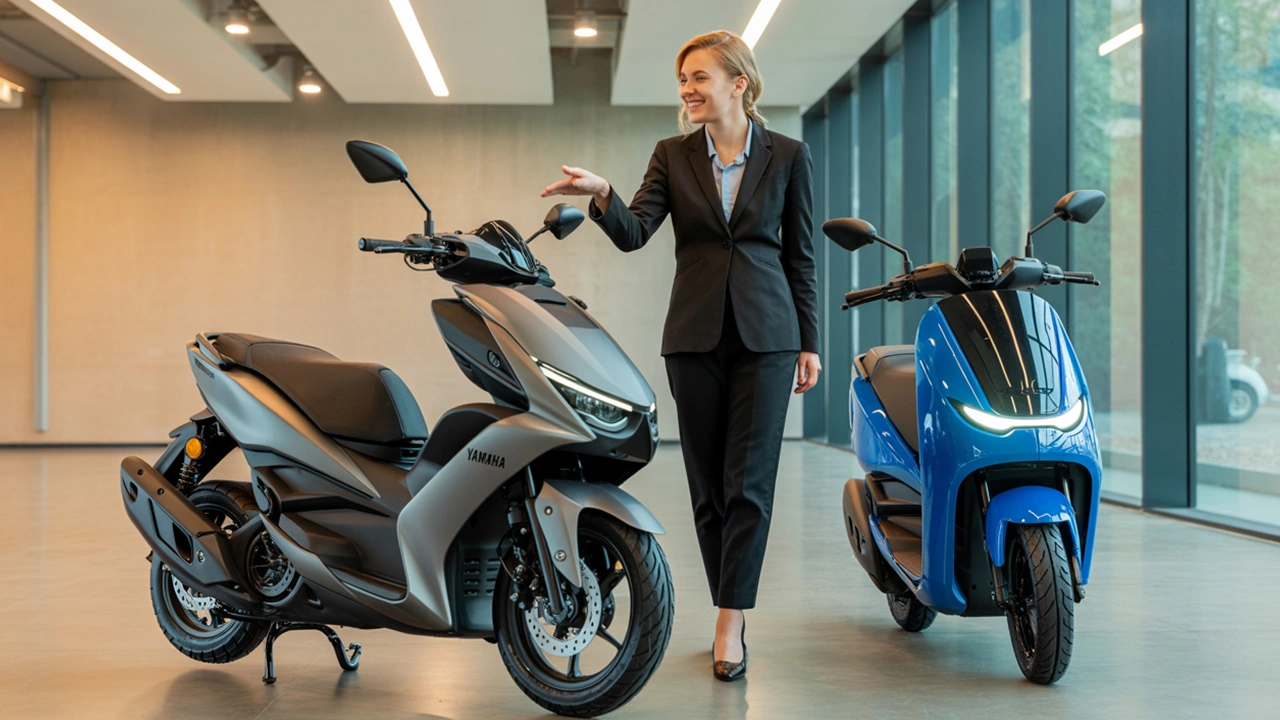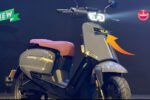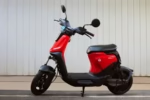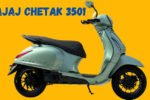In 2025, India’s two-wheeler market is evolving with two distinct offerings that cater to the growing needs of urban commuters. The Yamaha Aerox 155 and the Ola S1 Air are both vying for attention, but they represent two very different approaches to city mobility. One embraces traditional petrol power with a focus on performance, while the other highlights the push for electric mobility. With the rapidly changing landscape of urban commuting, which of these two scooters makes more sense for daily use? Let’s break down the key differences.
Design and Styling
The Yamaha Aerox 155 continues its sport-focused design with aggressive, moto-scooter styling. The 2025 model retains sharp bodywork, twin LED headlights, and a tall stance, giving it a more sportbike-like feel than a traditional scooter. This design appeals to younger riders and those looking for performance with flair.
In contrast, the Ola S1 Air embraces a clean, minimalist design that aligns with the growing trend of electric vehicles. Its flat floorboard, simple curves, and vibrant color options give it a futuristic yet practical look. The S1 Air may not turn heads in the same way the Aerox does, but it aligns well with the evolving EV mindset, focusing more on practicality for everyday use.
Verdict: The Aerox 155 grabs attention with its sporty, aggressive styling, while the Ola S1 Air focuses on a sleek, modern design better suited for daily urban rides.
Performance and Ride Experience
The Yamaha Aerox 155 is powered by a 155cc liquid-cooled engine borrowed from the R15 V4, generating around 15 PS. It’s one of the most powerful scooters in India, capable of quick acceleration and providing a thrilling ride. The CVT transmission ensures smooth power delivery, making it excellent for overtaking on highways or fast-paced city commutes.
On the other hand, the Ola S1 Air is powered by a 4.5 kW electric motor, offering a top speed of 90 km/h and a claimed 0-40 km/h time of 3.3 seconds. While it doesn’t match the outright power of the Aerox, the electric motor provides instant torque, which is a big advantage in stop-and-go traffic, delivering smooth and silent acceleration.
Verdict: The Aerox 155 is more exciting at high speeds and for riders seeking performance, while the Ola S1 Air offers a smoother, quieter experience ideal for city commuting with immediate torque delivery.
Range vs Mileage
In terms of fuel efficiency, the Yamaha Aerox 155 delivers around 40–45 kmpl in real-world conditions. With its 5.5L fuel tank, it offers a range of over 200 km on a full tank, making it reliable for longer trips without the worry of frequent refueling.
The Ola S1 Air, on the other hand, offers a claimed range of 125 km per charge (IDC) and takes around 4–5 hours to fully charge. For those with a home charging setup, this can translate into lower running costs over time, though the range might require more frequent charging, especially for longer commutes.
Verdict: The Ola S1 Air wins in terms of daily cost savings with its electric powertrain, while the Aerox 155 provides flexibility with its longer range and no charging anxiety.
Features and Tech
Yamaha has made significant updates to the Aerox 155 for 2025, including Bluetooth connectivity, a digital LCD display, and traction control for improved safety and performance. It also offers keyless ignition in select variants, adding convenience to the mix.
On the other hand, the Ola S1 Air is a tech-laden scooter with a touchscreen dashboard, multiple riding modes, navigation, OTA updates, and even reverse mode. These features make it more connected and convenient for tech-savvy riders who want a more futuristic riding experience.
Verdict: The Ola S1 Air dominates when it comes to features and smart functions, offering a more connected and high-tech experience. The Aerox 155 keeps it more traditional with a focus on sporty functionality.
Ride Comfort and Usability
The Yamaha Aerox 155 features 14-inch wheels and telescopic forks, providing a smooth ride on highways. However, its relatively high seat height (790 mm) and narrow footboard (due to the fuel tank tunnel) make it feel more like a step-through motorcycle than a traditional scooter. This setup might be less comfortable for riders looking for convenience during daily chores or for carrying passengers.
The Ola S1 Air is designed with comfort in mind. It has a flatter seat, a lower seat height (792 mm), softer suspension, and a spacious floorboard, making it ideal for daily commuting and family use. The more relaxed riding posture and ease of handling make it better suited for the average urban rider.
Verdict: The Ola S1 Air is more comfortable for daily use, offering a more practical setup for commuting and carrying a pillion. The Aerox 155 is sportier but less focused on comfort.
Pricing and Value for Money
In terms of pricing:
- The Yamaha Aerox 155 (2025) is priced around ₹1.50 lakh (ex-showroom).
- The Ola S1 Air is priced at ₹1.20 lakh (ex-showroom, after subsidy).
While the Aerox 155 offers premium hardware, performance, and sporty styling, the Ola S1 Air provides more features and an electric powertrain at a lower cost. Additionally, the S1 Air offers long-term savings due to its lower running costs and reduced maintenance.
Verdict: The Ola S1 Air offers better value for money, especially for daily commuting and long-term savings. The Aerox 155 justifies its higher price with superior performance and premium features for performance-focused riders.
Which One Should You Pick?
Choosing between the Yamaha Aerox 155 (2025) and the Ola S1 Air ultimately depends on what you value more.
- If you’re a performance lover who enjoys speed, sportbike styling, and occasional highway runs, the Aerox 155 will be more suitable despite its higher cost.
- If you prefer low running costs, high-tech features, and an eco-friendly ride, the Ola S1 Air offers unmatched practicality for daily city commuting at a more affordable price.
Both scooters cater to different segments of the urban commuter market—Aerox is ideal for those seeking excitement and performance, while the Ola S1 Air is perfect for those looking for an efficient, tech-packed, and sustainable commuting solution.
FAQs
How does the Yamaha Aerox 155 compare to the Ola S1 Air in terms of performance?
The Aerox 155 offers superior power with its 155cc engine, making it faster and more exciting for high-speed riding. The Ola S1 Air, however, offers smoother and quieter acceleration, perfect for city traffic.
Which scooter offers better fuel efficiency?
The Ola S1 Air is more cost-efficient in terms of daily running costs due to its electric motor, while the Aerox 155 delivers around 40–45 kmpl, providing a longer range between fuel stops.
Is the Ola S1 Air comfortable for daily use?
Yes, the Ola S1 Air is designed with comfort in mind, featuring a lower seat height, softer suspension, and a spacious floorboard, making it ideal for daily commuting.
Which scooter offers more advanced technology?
The Ola S1 Air is equipped with a touchscreen dashboard, multiple riding modes, OTA updates, and navigation, offering more advanced tech than the Aerox 155, which focuses more on performance and sporty features.
What is the pricing difference between the two scooters?
The Aerox 155 is priced at ₹1.50 lakh (ex-showroom), while the Ola S1 Air is priced at ₹1.20 lakh (ex-showroom, after subsidy).




